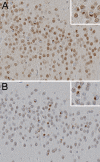TDP-43 immunoreactivity in hippocampal sclerosis and Alzheimer's disease
- PMID: 17469117
- PMCID: PMC2677204
- DOI: 10.1002/ana.21154
TDP-43 immunoreactivity in hippocampal sclerosis and Alzheimer's disease
Abstract
Objective: This study aimed to determine the frequency of frontotemporal lobar degeneration with ubiquitinated inclusions (FTLD-U) in the setting of hippocampal sclerosis (HpScl) and Alzheimer's disease (AD) using immunohistochemistry for TAR DNA binding protein 43 (TDP-43), a putative marker for FTLD-U.
Methods: Initially, 21 cases of HpScl associated with a variety of other pathological processes and 74 cases of AD were screened for FTLD-U with TDP-43 immunohistochemistry. A confirmation study was performed on 93 additional AD cases. Specificity of TDP-43 antibodies was assessed using double-immunolabeling confocal microscopy, immunoelectron microscopy, and biochemistry.
Results: TDP-43 immunoreactivity was detected in 71% of HpScl and 23% of AD cases. Double immunostaining of AD cases for TDP-43 and phospho-tau showed that the TDP-43-immunoreactive inclusions were usually distinct from neurofibrillary tangles. At the ultrastructural level, TDP-43 immunoreactivity in AD was associated with granular and filamentous cytosolic material and only occasionally associated with tau filaments. Western blots of AD cases showed a band that migrated at a higher molecular weight than normal TDP-43 that was not present in AD cases without TDP-43 immunoreactivity.
Interpretation: These results suggest that as many as 20% of AD cases and more than 70% of HpScl cases have pathology similar to that found in FTLD-U. Whether this represents concomitant FTLD-U or is analogous to colocalization of alpha-synuclein and tau in AD, reflecting a propensity for codeposition of abnormal protein conformers, remains to be determined.
Figures







References
-
- McKhann GM, Albert MS, Grossman M, et al. Clinical and pathological diagnosis of frontotemporal dementia: report of the Work Group on Frontotemporal Dementia and Pick's Disease. Arch Neurol. 2001;58:1803–1809. - PubMed
-
- Bergmann M, Kuchelmeister K, Schmid KW, et al. Different variants of frontotemporal dementia: a neuropathological and immunohistochemical study. Acta Neuropathol (Berl) 1996;92:170–179. - PubMed
-
- Lipton AM, White CL, 3rd, Bigio EH. Frontotemporal lobar degeneration with motor neuron disease-type inclusions predominates in 76 cases of frontotemporal degeneration. Acta Neuropathol (Berl) 2004;108:379–385. - PubMed
-
- Snowden JS, Neary D, Mann DM. Frontotemporal dementia. Br J Psychiatry. 2002;180:140–143. - PubMed
MeSH terms
Substances
Grants and funding
LinkOut - more resources
Full Text Sources
Other Literature Sources
Medical

